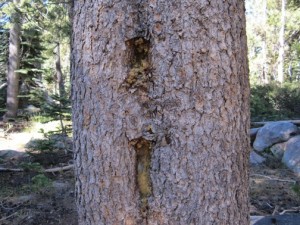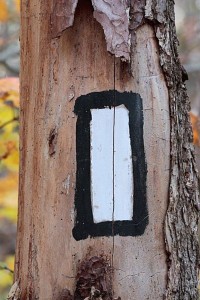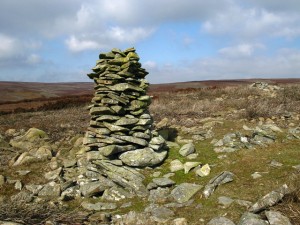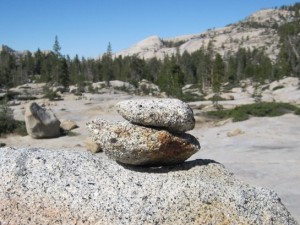Trail Reading Learning Objectives
After completing this section you should be able to:
- Identify basic trail etiquette
- Identify and interpret trail blazes
- Identify and interpret trail cairns
- Identify and interpret trail ducks
In heavily trafficked areas, a well designed and well worn trail is fairly easy to stay on. We often travel with confidence for miles without feeling the need to reference our maps, compasses, or GPS units.
Identify Basic Trail Etiquette
Navigating as a group means not only do you need to know where you are, but you need to know where everyone else is too. On a trail there are some common etiquette rules which when followed can help you stay together and on track.
- An experienced trekker should take the lead. No one should pass the leader unless you re-establish roles and responsibilities.
- An experienced trekker should be assigned as the sweeper (also known as taking up the rear). No one should be allowed to fall behind the sweeper.
- Spreading out on well established trails can keep you from eating each others dust, and it decrease your impact on the environment.
- When traveling cross-country (where there is no clear trail to follow) the group should remain within eye and ear contact.
Because trail signs have to be read, there is always risk they may not be interpreted in the same way. Even on well established trails, to decrease the odds of the group getting too separated, there are times you will need to stop. Some groups carry two-way radios, which can be used to keep contact between the front and back of the group. With or without radios, the leader of the group should stop, gather up the team and get consensus on what to do next whenever the following is encountered:
- a split in the trail
- a water crossing
- an obstacle like a downed tree
- the trail seems to fade
- anything confusing or ambiguous
These occasional re-groupings also prevent long distances being established between members of the team. If someone in the back is having equipment problems or an injury, the sooner you figure that out the better.
If you encounter others on the trail, share information. Ask where they are coming from. Ask about trail conditions, water sources, potential camp sites and even mosquitoes. Share your information. Most trekkers are friendly, and the information shared is extremely valuable to staying on track.
For some of us, however, our reason for being in the wilderness is to get away. This goal may lead us away from the heavy traffic areas to more primitive trails, where we may travel for days without seeing another person. These adventures may take us through overgrown vegetation, above the tree lines, or into wide open granite spaces, where trails are less obvious.
When following primitive trails, we may find our selves looking for “confidence markers”. Some sign that others have been here before, and that we are generally headed in the right direction. Although varying somewhat from region to region, there are three basic trail makers which can assist us: blazes, cairns , and ducks.
Identify and Interpret Trail Blazes

In heavily wooded areas, trail blazes are often marked on trees. The markings may vary by trail or agency, but they are generally found at eye level, easily visible even in deep snow. In earlier times, blazes were carved into the tree with an axe or a knife. The US Forest Service standard for carved blazes resembled a blocked letter lower case “i”. Although falling out of favor for environmental reasons, in many parts of the country these carved blazes can still be found. Because most are not being “re-carved”, the bark is beginning to grow back, making them less obvious.

More common tree blazes now are painted. The color of the blaze is often associated with the trail or agency. Although not universal, there are some fairly common standards to indicate direction. A single blaze means straight ahead. For double blazes, the top blaze indicates the turn direction. If the top blaze is to the right of the bottom blaze turn right. If it is to the left, turn left. In some areas, one blaze directly above the other means caution or end of trail. Because they may vary region to region, make sure you understand the meaning in your area.

When traveling in a wildernesses where tree blazing is not allowed, or when traveling above the tree line or through open granite, unnatural looking rocks piles are typically used as markers
Identify and Interpret Trail Cairns

In locations of heavy fog and snow, cairns are sometimes used. A cairn is a large pile of rocks, typically 3 feet high and 2 or more feet wide. More common perhaps in the east than the west, these piles are visible in even the worst conditions, helping the hiker to find his way home. It is also said to be good luck if you add a rock to the cairn, which may explain their enormous and growing size. The effort involved in creating a large cairn should provide some confidence you are on the correct path, or at least a well traveled path. Not many people would take the time to build such a large structure unless they were confident about its location.
Identify and Interpret Trail Ducks

In other regions, ducks are more commonly used. A duck is a much smaller rock pile, typically stacked just high enough to convince the observer it is not natural. For most, two rocks stacked could be a coincidence, but three rocks stacked is a duck. In some regions, ducks also contain a pointer rock (or couple of stacked rocks) to indicate the direction of the trail.

The upside of ducks is that they are very easy to construct, and where used you are likely to find many of them. The downside of ducks is that they are very easy to construct and where used you are likely to find many of them. Because so little effort is involved in creating a duck, and because lost people seem to love to make them, they may not provide you the desired level of confidence. In fact, in some areas, they are more like graffiti than trail marker.
When in serious doubt, you should rely on your map, compass, and GPS for location and direction guidance. As you are moving throughout the wilderness, however, these standard trail markers: blazes, cairns and ducks, provide gentle visual “confidence builders” that may help convince you that you are on the right trail. If not, you may find yourself quoting Daniel Boone, who reportedly said
“I’ve never been lost, but I was mighty turned around for three days once.”
Other Environmental Signs
With common sense and knowledge of your local region, you may be able to take notice of other environmental signs to affirm or conflict with your current navigational assumptions. For example the sun rises in the east and sets in the west. Does its currently location and movement agree with your assumption? Rivers in this particular area tend to flow from east to west, toward the ocean, does that agree? Wind generally blows from west to east in this location, does that agree? Taken in isolation, these assumption are dangerous, but combined with other factors, can be very helpful to environment reading.
Trail Reading Review
You should now be able to:
- Identify basic trail etiquette
- Identify and interpret trail blazes
- Identify and interpret trail cairns
- Identify and interpret trail ducks
